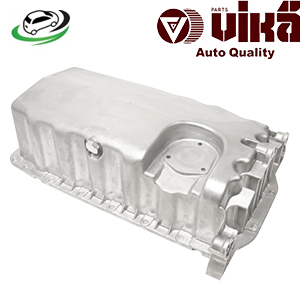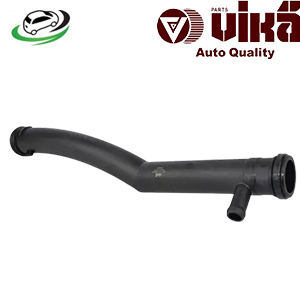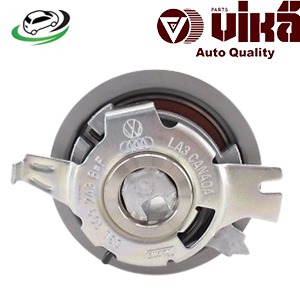-8%
Get Volkswagen Passat B7 TDI Timing belt tensioner 03L109243F
A timing belt tensioner is a device responsible for applying the correct amount of tension to the timing belt, ensuring that it stays in place while the engine operates. The tensioner is typically spring-loaded or hydraulically controlled and works in tandem with the timing belt, crankshaft, and camshaft.
Without proper tension, the timing belt may slip, skip teeth, or come loose, causing the engine’s valves and pistons to fall out of sync, which can lead to severe engine damage. In modern interference engines, where the pistons and valves share the same space at different times, a malfunctioning tensioner could cause them to collide, resulting in costly repairs.
2. How Does a Timing Belt Tensioner Work?
The timing belt tensioner is designed to apply continuous pressure on the timing belt to keep it tight and properly aligned. This tension is crucial for maintaining synchronization between the crankshaft and camshaft(s), which controls the opening and closing of the engine’s intake and exhaust valves.
The tensioner functions as follows:
- Maintaining Tension: The tensioner applies constant pressure on the timing belt to ensure it remains taut. This prevents the belt from slipping, which would cause the engine’s timing to be thrown off.
- Absorbing Vibrations: The tensioner helps absorb vibrations and fluctuations in the belt’s tension as the engine operates, ensuring smooth and quiet operation.
- Adjusting Automatically: Many timing belt tensioners are designed to automatically adjust over time to compensate for belt stretch and wear. This automatic adjustment ensures consistent belt tension throughout the life of the belt.
3. Types of Timing Belt Tensioners
Timing belt tensioners come in different types, each suited for specific engine designs and performance needs. The most common types include:
1. Manual Tensioner
- Design: A manual tensioner requires manual adjustment during installation. The mechanic sets the belt tension by tightening or loosening the tensioner’s bolts.
- Advantages: Simple and cost-effective; suitable for engines with less dynamic tensioning needs.
- Disadvantages: Requires periodic adjustments as the belt stretches over time; incorrect tensioning can cause belt failure or reduced performance.
2. Spring-Loaded Tensioner
- Design: A spring-loaded tensioner uses a coil spring to apply continuous pressure to the timing belt. The tension is automatically adjusted as the belt stretches.
- Advantages: Low-maintenance and self-adjusting, making it easier to install and operate over time.
- Disadvantages: The spring can weaken over time, leading to reduced tension and potential belt slippage.
3. Hydraulic Tensioner
- Design: A hydraulic tensioner uses hydraulic pressure to maintain consistent belt tension. It typically includes an internal piston and oil reservoir.
- Advantages: Provides precise, automatic adjustments, making it highly reliable in maintaining consistent tension, especially in high-performance engines.
- Disadvantages: More complex and expensive compared to manual or spring-loaded tensioners. Hydraulic tensioners can also fail due to oil leaks or loss of hydraulic pressure.
4. Combined Tensioner (Hydraulic and Spring)
- Design: Some modern tensioners combine both hydraulic and spring mechanisms, offering the best of both worlds.
- Advantages: These tensioners offer superior tension control and durability.
- Disadvantages: Higher cost and complexity, requiring expert installation and maintenance.
4. Functions of a Timing Belt Tensioner
The timing belt tensioner performs several crucial functions in the engine’s timing system, ensuring efficient operation:
- Maintaining Timing Accuracy: By keeping the timing belt properly tensioned, the tensioner ensures that the camshaft and crankshaft remain synchronized. This synchronization is vital for the precise timing of the engine’s intake and exhaust valve operation.
- Preventing Belt Slippage: The tensioner prevents the timing belt from slipping or jumping teeth on the gears. Even slight slippage can lead to timing issues, poor engine performance, or engine failure.
- Absorbing Vibrations: The tensioner helps reduce vibrations and oscillations in the belt as the engine operates, leading to smoother, quieter performance.
- Compensating for Belt Stretch: Over time, the timing belt will naturally stretch due to heat, wear, and mechanical stress. The tensioner compensates for this stretch by automatically adjusting its tension to maintain the correct belt tightness.
5. Benefits of a Properly Functioning Timing Belt Tensioner
A properly functioning timing belt tensioner provides several important benefits for engine performance and longevity:
- Ensures Proper Engine Timing: The tensioner helps maintain the correct timing between the crankshaft and camshaft, ensuring that the engine’s valves and pistons are properly synchronized. This prevents engine misfires and optimizes engine performance.
- Prevents Engine Damage: In interference engines, where the valves and pistons share space in the combustion chamber, a malfunctioning tensioner can cause the timing belt to slip or break. This could lead to a collision between the valves and pistons, resulting in costly engine damage. A properly functioning tensioner prevents this by keeping the belt in place.
- Prolongs Timing Belt Life: By maintaining the correct tension, the tensioner helps reduce wear and tear on the timing belt, prolonging its life. This reduces the risk of premature belt failure.
- Reduces Noise and Vibration: A well-maintained tensioner helps reduce engine noise and vibration, contributing to a quieter, smoother ride.
- Lower Maintenance Costs: Regular maintenance of the tensioner reduces the likelihood of major engine damage, potentially saving thousands of dollars in repair costs.
6. Common Issues with Timing Belt Tensioners
Like any engine component, the timing belt tensioner can experience issues over time. Some of the most common problems include:
- Loss of Tension: A worn or faulty tensioner may lose the ability to maintain proper tension on the belt. This can lead to belt slippage, misaligned timing, or even belt failure.
- Excessive Wear: Over time, the tensioner’s internal components, such as springs or hydraulic pistons, can wear out. Worn components can cause the tensioner to become less effective at maintaining proper belt tension.
- Belt Misalignment: A misaligned tensioner can cause the timing belt to wear unevenly or slip off its pulleys. This can lead to premature belt failure or engine damage.
- Hydraulic Fluid Leaks: Hydraulic tensioners rely on oil pressure to maintain proper tension. A leak in the tensioner can cause a loss of hydraulic pressure, leading to belt slack and poor engine performance.
- Noisy Operation: A failing tensioner may produce unusual noises, such as rattling or squeaking, due to worn bearings or excessive slack in the belt.
7. Symptoms of a Failing Timing Belt Tensioner
A failing tensioner can present several symptoms, alerting drivers to potential issues. These include:
- Engine Misfires: A loose or slipping timing belt can cause the engine’s valves and pistons to become out of sync, leading to misfires.
- Squealing or Rattling Noise: Unusual noises from the engine, particularly near the timing belt area, can indicate a failing tensioner. Squealing or rattling sounds often result from a loose belt or worn tensioner bearings.
- Engine Overheating: A faulty tensioner may cause the timing belt to slip, leading to poor engine performance and, in some cases, engine overheating.
- Check Engine Light: If the engine’s timing is off due to a faulty tensioner, it may trigger the check engine light.
- Visible Belt Wear: If the timing belt appears frayed, cracked, or excessively worn, it could be a sign that the tensioner is not maintaining proper tension.
8. Maintenance and Replacement of Timing Belt Tensioner
To avoid serious engine issues, regular maintenance of the timing belt tensioner is crucial. Here are some key maintenance tips:
Regular Inspections
- Periodically inspect the timing belt and tensioner for signs of wear, noise, or misalignment. If the belt or tensioner appears worn or damaged, replacement should be carried out immediately.
Timing Belt Replacement
- Most manufacturers recommend replacing the timing belt and tensioner together at specific intervals, usually between 60,000 and 100,000 miles. Replacing both components at the same time ensures consistent performance and prevents premature failures.
Listen for Noises
- Pay attention to any unusual engine noises such as squealing, rattling, or grinding, which could indicate tensioner or belt issues. Early detection can prevent major engine damage.
Replace Worn Components
- If the tensioner or its components, such as springs or hydraulic seals, show signs of wear, replace them immediately. Worn tensioners can lead to belt slippage or failure.
Consult the Manufacturer’s Guidelines
- Always follow the vehicle manufacturer’s guidelines for timing belt and tensioner maintenance, as each engine design may have specific requirements.
Follow us on Facebook for more parts.




Reviews
Clear filtersThere are no reviews yet.